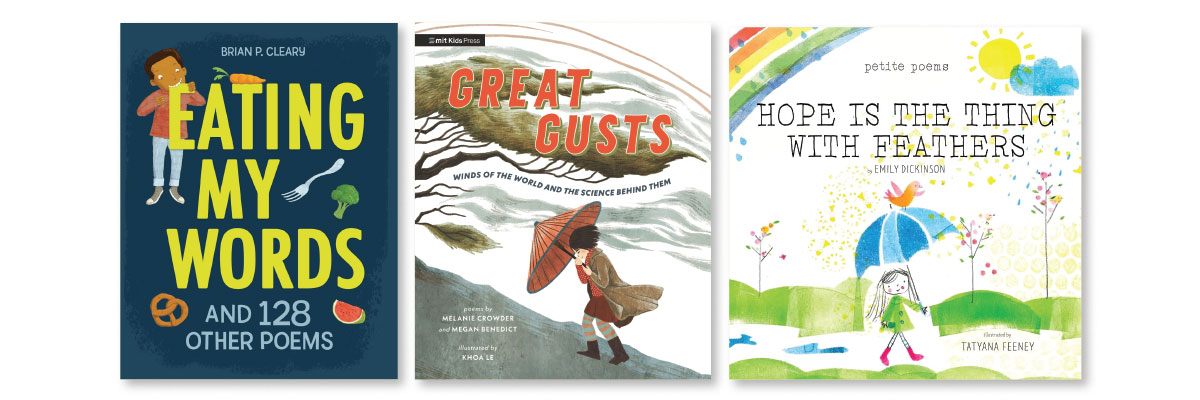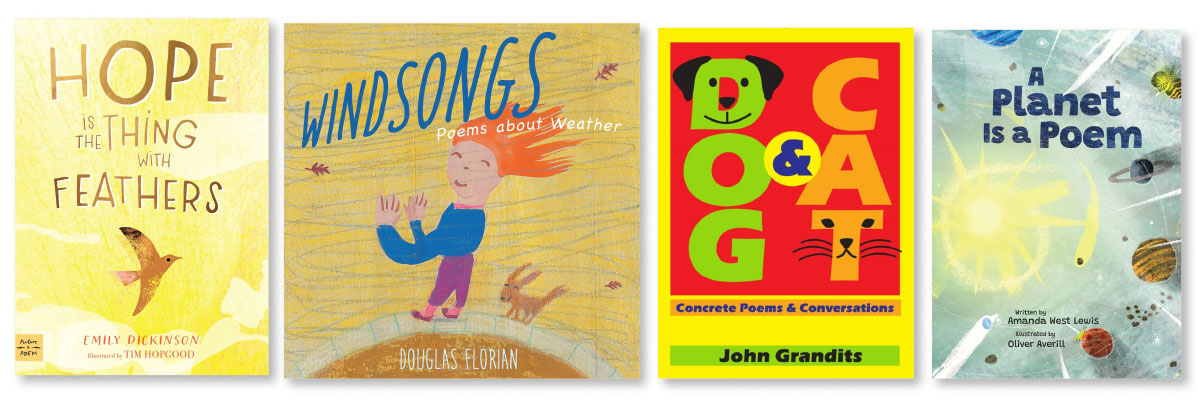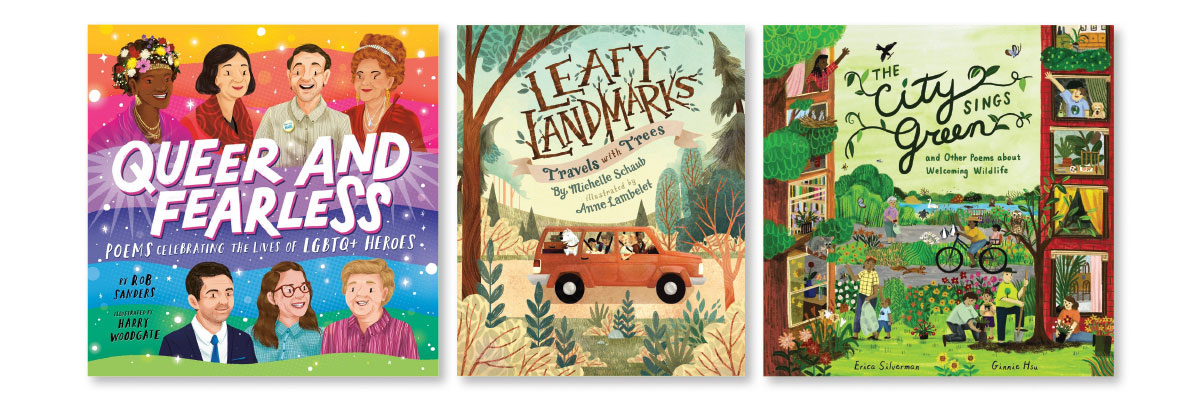10 Poetry Books for Children of All Ages | Poetry Roundup
From poems about planets and trees to poems about LGBTQIA+ heroes, young readers from elementary through high school will find something to enjoy here. Share these titles for National Poetry Month and all year long.

From poems about planets and trees to poems about LGBTQIA+ heroes, young readers from elementary through high school will find something to enjoy here. Share these titles for National Poetry Month and all year long.
CLEARY, Brian P. Eating My Words: And 128 Other Poems. illus. by Andy Rowland & Richard Watson. 120p. Millbrook. Mar. 2024. Tr $34.65. ISBN 9781728487649.
Gr 1-4–This inventive collection boasts a dual identity: It’s simultaneously a book of poems and a primer on poetic craft. Nearly every page features a sidebar or footnote inviting readers to examine the structure of the verse, as well as its content. Bolstered by a thorough glossary, Cleary adroitly explores concepts of meter and rhyme and defines linguistic concepts, such as alliteration, simile, and personification. His precise, uncomplicated language makes these explanations accessible and appealing, and he cannily draws the eye toward helpful examples by asking, “Did you notice…?” Along the way, readers are introduced to poetic forms from around the world, including the French villanelle, the Indian doha, the Italian rispetto, and the Malaysian pantoum. As noted in the front matter, several pieces were published in the author’s previous collections, as were some of Rowland and Watson’s zany cartoon illustrations. Is the artistry itself as successful as the instructional content? On the whole, yes. Cleary’s writing is lively, earnest, and visually playful, with concrete poems, acrostics, rebuses, and even music-note letter substitutions providing spirited entertainment. While a few entries pass by without much impact, many strike an arresting tone, particularly the Japanese tanka “Dead to Me,” which likens a shoebox to “a cardboard coffin,” and the wistful, pun-filled ballad “When I Am No Longer,” which declares, “They can give my arms to the army,/ take my eyes of blue,/ and give my knees to the needy,/ but my heart goes out to you.” VERDICT An excellent addition to poetry collections, this volume will excite and engage, and—most importantly—it will empower children to write poems of their own.–Jonah Dragan
CROWDER, Melanie & Megan Benedict. Great Gusts: Winds of the World and the Science Behind Them. illus. by Khoa Le. 48p. Candlewick/MIT Kids. Mar. 2024. Tr $18.99. ISBN 9781536224511.
Gr 4-6–“Can you ever really see the wind?” “Can you ever really know the wind?” Two short questions and poetic suggestions toward the beginning of this book invite readers to experience wind. “Lift your face to the breeze—/ let it bathe your cheeks/ sift through your hair/ tease your fingertips./ Listen/ while the wind whispers its name.” This fanciful idea of the whisper leads directly to the “Bull’s-Eye Squall,” a poem about the squall blowing off the coast of South Africa. The winding tour goes on through 13 more places around the world where specially named winds blow across land, water, mountains, cities, deserts, and snowy expanses. Stops include Japan, the Pennine Mountain Range in Northern England, Malaysia, Singapore, and the Windy City of Chicago. Short lines of poetry, mostly blank verse, flow down picture book pages to terse explanations. Simple, digitally created scenes often include children, sometimes with a local animal. Softly shaded sweeps of sky and curving lines swirling everywhere show the wind’s direction. End materials add brief comments on air in motion making the wind, the local naming of wind, and local poetic traditions used in a few poems. Geographic locations of the listed winds are shown as numbers on a circular globe, and there’s a glossary and short bibliography of related children’s books. The picture book format suggests a younger audience, but children in the middle grades will likely not be familiar with all of the named locations or readily grasp the fairly technical explanations. Some poems read aloud could spark classroom discussion and lead to further study of the ever-growing presence of wind. VERDICT Put this book of poems in the hands of talented science teachers.–Margaret Bush
DICKINSON, Emily. Hope Is the Thing with Feathers. illus. by Tatyana Feeney. 24p. (Petite Poems). Cameron Kids. Mar. 2024. Tr $15.99. ISBN 9781951836948.
PreS-Gr 2–Emily Dickinson’s classic poem is brought to life in vibrant hues in this new addition to the “Petite Poems” collection. In the beginning, a variety of tiny birds dance across the page, as a young pencil-outlined child collects a dropped feather. The lines of the poem alternate pages, as the child, friends, neighbors, and birds weather rain and wind, but still come out smiling, evoking the spirit of hope explored in the poem. While the vocabulary and language of the poem might be challenging for young readers on their own, Feeney’s illustrations are accessible and easy to follow. The full text of the poem, as well as a brief bio, appear at the end of the book, along with prompts for readers to think about how hope might manifest in their own lives. VERDICT An endearing addition to collections where poetry books are popular, or a suitable choice for National Poetry Month.–Kaitlin Malixi

DICKINSON, Emily. Hope Is the Thing with Feathers. illus. by Tim Hopgood. 32p. (Picture-a-Poem). Paw Prints. Mar. 2024. Tr $18.99. ISBN 9781223188164.
Gr 1-5–Unlike humor poets Shel Silverstein and Jack Prelutsky, who have wide appeal to the school-age set, romantic poetry can be tricky for young readers who prefer a tidy narrative. Dickinson’s “Hope Is the Thing with Feathers” offers a just-right sojourn for children into the metaphoric language of poetry. Its subject has a modern-day relevance that will inspire engaging discourse, both in classrooms and at home. Hopgood’s interpretations of the classic poem provide consistent visual mooring for Dickinson’s text, depicting the resilience of hope in the form of a songbird whose song survives the many obstacles life puts in the way. In Dickinson’s parting stanza, “Yet - never - in Extremity, It asked a crumb - of me,” provides a fruitful opportunity for meaningful exchange between little ones and their grown-ups. VERDICT A fine foray into canonical poetry for young learners.–Sarah Simpson
FLORIAN, Douglas. Windsongs: Poems About Weather. illus. by Douglas Florian. 48p. S. & S./Beach Lane. May 2024. Tr $18.99. ISBN 9781665937726.
PreS-Gr 1–This nonfiction picture book blends the beauty of weather with the elegance of poetry through its unique and memorable style. Each spread features a different element of weather, including types of storms, instruments used to measure weather, and more. The verses all vary in style, incorporating some rhymes and visual stylings to connect the words with their topics of focus. Many poem selections resemble a weather type, such as a spiral for a hurricane and lightning emerging from a cloud. These artistic choices serve the dual purpose of introducing children to the varied ways in which poetry can be created, as well as providing readers with a memorable way of recognizing weather features. Facing each poem is an accompanying illustration that embraces childlike art, using visible pencil lines, asymmetrical imagery, and muted hues. Together, the text and pictures make the concept of weather accessible to a very young audience, especially when used to teach about weather for the first time. A glossary provides more detailed information about each featured weather type, enhancing the learning that can happen thanks to this book. VERDICT A unique and accessible title that helps young children connect to weather in a foundational and introductory manner.–Mary Lanni
 GRANDITS, John. Dog & Cat: Concrete Poems & Conversations. illus. by John Grandits. 48p. Carus Kids. Aug. 2024. pap. $9.95. ISBN 9781637700501.
GRANDITS, John. Dog & Cat: Concrete Poems & Conversations. illus. by John Grandits. 48p. Carus Kids. Aug. 2024. pap. $9.95. ISBN 9781637700501.
Gr 3-7–Along with their human family, Dog and Cat are moving. Immediately, classic emotions emerge: denial, anger, and sadness. Dog freaks out, while Cat tries to help him accept the inevitable. But is Cat really fine? Each of them works to console the other in a charming, sweet, and funny sidebar series of conversations during days of cat napping, eating, chasing squirrels, and supporting their humans, Boy and Girl. Can they figure out how to stop this dreadful move? Only when Cat decides to take action does more chaos ensue. Grandits has artfully crafted a story of tension embedded in concrete poems in order to share the fervor of what it means to move to a new home. His perfect approach is filled with bright colors, squiggly lines, tilting text, and simple graphic line depictions of cat and dog, while the text is flawlessly done in obscure fonts, causing yet more humor as readers must at times shift, tilt, turn, tip, and angle the book to capture the earnest and energetic reactions of a family on the move. VERDICT A heartwarming and nerve-racking poem that accurately portrays one family’s emotional roller-coaster, told in the voices of its feline and canine companions, and a must-have for libraries.–Lyn Smith
 LEWIS, Amanda West. A Planet Is a Poem. illus. by Oliver Averill. 40p. Kids Can. May 2024. Tr $19.99. ISBN 9781525304422.
LEWIS, Amanda West. A Planet Is a Poem. illus. by Oliver Averill. 40p. Kids Can. May 2024. Tr $19.99. ISBN 9781525304422.
Gr 3-5–A combined exploration of poetry and our solar system, this book covers both with an eye for detail. A brief overview of planets and poetry begins the narrative. The poems cover the solar system from planets to belts, and what lies beyond. Each poem is on a gatefold atop a spread. Under the gatefold is a rectangle with a couple of paragraphs sharing facts about the poem’s topic. On the back of the poem page, a circle contains an explanation of the type of poetry used. The illustrations are in bright hues with collage-style drawings. For example, Jupiter is shown against a blue background with a rocket heading towards it. The text of the concrete poem, “Jupiter the Giant,” is written on the exterior of the planet in different colors: “The Giant Red Spot is shrinking, tearing off, vanishing, into spinning clouds.” The fact rectangle tells Jupiter’s place in and impact on the creation of our solar system. Fourteen different types of poetry feature the sun through the Kuiper Belt, with a mention of the mysterious potential Planet X. The final illustration shows the full solar system. Lewis ends the book by encouraging readers to write poems based on Planet X. A glossary and resources are provided. VERDICT This combination of poems and planets is a fun way to introduce readers to both. An excellent purchase, though the full-page gatefolds may limit shelf life.–Tamara Saarinen

SANDERS, Rob. Queer and Fearless: Poems Celebrating the Lives of LGBTQ+ Heroes. illus. by Harry Woodgate. 32p. Penguin Workshop. Apr. 2024. Tr $18.99. ISBN 9780593523698.
Gr 3 Up–An anthology of poems celebrating 17 LGBTQIA+ heroes, past and present. Insightful biographies of each hero, paired with an accompanying poem and colorful illustrations, will appeal to young readers. In “Gilbert Designed a Flag,” colors of the Rainbow Flag float across the pages, as the poem describes how gay rights activist Gilbert Baker was inspired to sew a flag that represented the gay community and all its members. “As a community they came together/ They marched, they cheered/ A waving rainbow the way/ Gilbert’s flag was for them all.” In “Marsha P. Started an Uprising,” each line of the acrostic poem starts with a letter from the alphabet to describe Johnson’s actions to liberate and advocate for transgender rights. The poem packs inspiration into each line. Sanders features diverse cultural representations of the LGBTQIA+ community, including African American, Latinx, and Asian American members. LGBTQIA+ topics and history are described in an age-appropriate way in a glossary. Other back matter includes an author’s note, additional reading, “A Word About Pronouns,” and a list of the poems with their forms, such as quatrain, senryu, limerick, free verse, and others. Due to the font size, long biographical texts, and subtitles in a font that may be difficult to read, this book is best suited for older elementary students. VERDICT A validation of self through historical heroes to engage readers in the classroom and at home. This book allows young readers to see that real-life heroes find the ability to make a difference by speaking their minds and letting their truths be known.–Dany’l Van Someren
SCHAUB, Michelle. Leafy Landmarks: Travels with Trees. illus. by Anne Lambelet. 40p. Sleeping Bear. Mar. 2024. Tr $18.99. ISBN 9781534112872.
Gr 3-7–In this engaging and creative introduction to poetry, Schaub weaves geography, botany, and history throughout the narrative of a family’s road trip to historical trees in the United States. Tree leaves flood the endpapers with poetry types and descriptions highlighted on the family’s journey. Lambelet’s digital art carefully layers the leaves, authentically providing texture and warmth, and the selection of fonts to identify tree species and landmarks suits each spread. “Hit the Road,” a quatrain, introduces the leafy adventure with a fantastic map of all the stops and provides opportunities for cross-curricular discovery. Each tree stop includes a poem with its listed form, the location and species of the tree, and a paragraph of information about why the tree is significant. California’s General Sherman, Nebraska’s Arbor Day Oak, Oklahoma City’s Survivor Tree, and the cherry trees of Washington, D.C., are some of the stops. Petrified Forest in Arizona is a study of contrasts and beauty, evoking the past and present through art and prose. Literary devices and forms are varied and the art provides further depth. “The Emancipation Tree” is the only piece that lacks consistency in word choice and framing. Its nonet poem, “Shady Haven,” discusses that people were “Slaves no more./ Hopeful./ Free.” In the informational text for this tree, it uses “enslaved African Americans” and “slaves.” It is an unfortunate blemish on an otherwise impressive book. The family of four is interracial; the father is a man of color, and the mother is light-skinned. VERDICT Recommended for poetry collections, although it is best suited for guided reading.–Rachel Zuffa
 SILVERMAN, Erica. The City Sings Green & Other Poems About Welcoming Wildlife. illus. by Ginnie Hsu. 40p. HarperCollins/Clarion. Apr. 2024. Tr $19.99. ISBN 9780358434566.
SILVERMAN, Erica. The City Sings Green & Other Poems About Welcoming Wildlife. illus. by Ginnie Hsu. 40p. HarperCollins/Clarion. Apr. 2024. Tr $19.99. ISBN 9780358434566.
PreS-Gr 3–Urban life, wildlife, and everyday life all artfully blend together in this notable book of poetry starring high-impact visuals, remarkable vocabulary, and impeccable rhyming verse with a smidgen of activism that quickly shows readers how humans intervene so nature can work her magic. For instance, in a Los Angeles schoolyard, a blacktop is removed and seeds are sown, as an oasis of wild flora invites a rare burrowing owl to take notice and move in. When migrating birds soar the Mississippi Flyway over Chicago, city dwellers adopt a voluntary Lights Out Chicago to protect the birds from artificial light distractions. These are only two examples of how Silverman showcases global environmental impacts of rewilding cities. Page by page, Silverman’s poetic mastery shines as she leads readers into her well-crafted world of rhyme and scientific information. This good narrative incorporates awareness of empathy and learning that Hsu artfully captures in her brightly colored drawings that deftly complement the prose. VERDICT The concept of worldwide changes to better support urban wildlife is told through exquisite rhymes wrapped around big, bold blossoms of color that, along with the plentiful learning resources, will captivate readers. A must-have poetry book worthy of close attention.–Lyn Smith
The job outlook in 2030: Librarians will be in demand
The job outlook in 2030: Librarians will be in demand
ALREADY A SUBSCRIBER? LOG IN
We are currently offering this content for free. Sign up now to activate your personal profile, where you can save articles for future viewing






Add Comment :-
Be the first reader to comment.
Comment Policy:
Comment should not be empty !!!